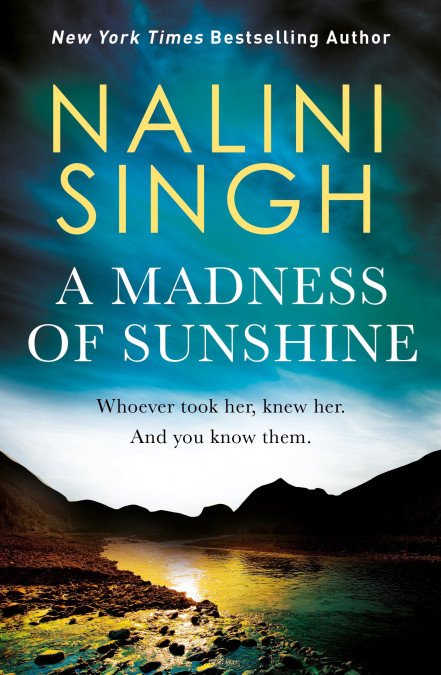Nalini Singh: A Madness of Sunshine review – a lacklustre thriller | reviews, news & interviews
Nalini Singh: A Madness of Sunshine review – a lacklustre thriller
Nalini Singh: A Madness of Sunshine review – a lacklustre thriller
Promising mystery set in small-town New Zealand falls prey to cliché

Nalini Singh's debut thriller thrusts us into Golden Cove, a small coastal town in New Zealand at "the edge of nowhere” that isn't everything it seems. What on the surface is a sun-bleached paradise made recently popular with back-packers is revealed to be much more sinister.
The vision of a fiercely self-contained town where everyone has known each other since childhood is shattered when Miriama, a bright-eyed, (and much over-mentioned) beautiful girl, disappears into thin air. At 19, having just received an illustrious photography scholarship, she was on the brink of an exciting new life far from home – a fact that strikes Anahera, our protagonist, as melancholy. Anahera returned to Golden Cove only days before, having left a decade earlier promising never to return. Having established herself in London, the death of her husband brought a stranger to her door who proved he wasn't who she thought he was. Wracked with grief, anger and an acute sense of disillusion, she took the long flight home.
 This return sets up the shaky, untrustworthy backdrop of Singh's story. The sense of simmering paranoia is only compounded by Will – a ruggedly handsome, mysterious cop who has been posted to the town after a catastrophic event in his past disgraced him in his career. He and Anahera meet when her car fails on her way into town and they are symbolically introduced on the boundary between where the town starts and ends. Anahera notices that a road sign, which wasn't there when she left all those years ago, on one side reads “Welcome to Golden Cove” and on the other, “Goodbye”.
This return sets up the shaky, untrustworthy backdrop of Singh's story. The sense of simmering paranoia is only compounded by Will – a ruggedly handsome, mysterious cop who has been posted to the town after a catastrophic event in his past disgraced him in his career. He and Anahera meet when her car fails on her way into town and they are symbolically introduced on the boundary between where the town starts and ends. Anahera notices that a road sign, which wasn't there when she left all those years ago, on one side reads “Welcome to Golden Cove” and on the other, “Goodbye”.
Though she’s suspicious, as the search for Miriama delves into the dark, guilty history of the town she finds Will to be a rock. They embark on a hunt for the truth and in so doing reveal not only what has happened to Miriama, but also solve a crime that rocked the community decades ago. Slowly, links are made, relationships crumble under the weight of truth and the characters learn they must bury the past if they are to ever look to the future.
This hackneyed moral does undoubtedly contain a measure of truth. The mystery of Miriama’s disappearance does unravel the town’s perception of itself – however Singh sadly fails to delve deeper. She repeats phrases, often to close off chapters dramatically. “Every couple has their secrets” or “it had to do with the town – and secrets” exemplify Singh’s failure to penetrate beyond platitudes and explore the darker themes of loss, the sometimes unexpected consequences of time passing, and characters’ motives. The novel barely touches the surface. Instead, frequent sign-posting removes much of the mystery of those secrets. The threatening darkness is pallid and the grand reveal lacks punch.
While some plot lines are pertinent and well-executed, characters’ back-stories are too visible. It feels less like their histories are fatefully entwined than deliberately constructed to signpost (otherwise admirable) themes such as “trauma”. For example, Will’s experience in a fire lit by a domestic abuser links him to Anahera’s own past, and while this should unify the two, the coincidence feels too uncanny. The reader is left shaking their head thinking, come on.
The character of the tortured, handsome cop is too clichéd from the outset. Like Anahera his defining characteristic is having a wall up that the other will predictably break down – which makes their will-they-won’t-they dance flat. Descriptions of female characters are at best uncomfortable. It could be argued that cringeworthy descriptions, such as “the blonde bunny”, are employed to show these women through the eyes of the many problematic male characters – but such sophistication feels lacking. Throughout the novel the dialogue is wooden, hardly like actual conversation (“‘The cafe’s quiet today with the weather predicted to turn nasty, so we can have a catch up,’” says Anahera’s best friend). As a result we don’t get enough insight to sympathise with, or relate to, them beyond clumsy dialogue and clichés such as “[she] walked into a thousand memories”.
In an attempt to flesh out her setting and characters, Singh's writing often over-describes mundane details. This is ultimately to the detriment of the reader who is denied the enjoyable power of inference – vital in thrillers. It’s true the narrative is well-paced and, like any great thriller, the ways in which blame is misdirected and reallocated, and evidence found and debunked, leads readers to doubt their suspicions at every twist. However, even readers after an easy page-turner are likely to find themselves wanting more.
- A Madness of Sunshine by Nalini Singh (Gollancz, £14.99)
- Read more book reviews on theartsdesk
rating
Explore topics
Share this article
The future of Arts Journalism
You can stop theartsdesk.com closing!
We urgently need financing to survive. Our fundraising drive has thus far raised £49,000 but we need to reach £100,000 or we will be forced to close. Please contribute here: https://gofund.me/c3f6033d
And if you can forward this information to anyone who might assist, we’d be grateful.

Subscribe to theartsdesk.com
Thank you for continuing to read our work on theartsdesk.com. For unlimited access to every article in its entirety, including our archive of more than 15,000 pieces, we're asking for £5 per month or £40 per year. We feel it's a very good deal, and hope you do too.
To take a subscription now simply click here.
And if you're looking for that extra gift for a friend or family member, why not treat them to a theartsdesk.com gift subscription?
more Books
 'We are bowled over!' Thank you for your messages of love and support
Much-appreciated words of commendation from readers and the cultural community
'We are bowled over!' Thank you for your messages of love and support
Much-appreciated words of commendation from readers and the cultural community
 Justin Lewis: Into the Groove review - fun and fact-filled trip through Eighties pop
Month by month journey through a decade gives insights into ordinary people’s lives
Justin Lewis: Into the Groove review - fun and fact-filled trip through Eighties pop
Month by month journey through a decade gives insights into ordinary people’s lives
 Joanna Pocock: Greyhound review - on the road again
A writer retraces her steps to furrow a deeper path through modern America
Joanna Pocock: Greyhound review - on the road again
A writer retraces her steps to furrow a deeper path through modern America
 Mark Hussey: Mrs Dalloway - Biography of a Novel review - echoes across crises
On the centenary of the work's publication an insightful book shows its prescience
Mark Hussey: Mrs Dalloway - Biography of a Novel review - echoes across crises
On the centenary of the work's publication an insightful book shows its prescience
 Frances Wilson: Electric Spark - The Enigma of Muriel Spark review - the matter of fact
Frances Wilson employs her full artistic power to keep pace with Spark’s fantastic and fugitive life
Frances Wilson: Electric Spark - The Enigma of Muriel Spark review - the matter of fact
Frances Wilson employs her full artistic power to keep pace with Spark’s fantastic and fugitive life
 Elizabeth Alker: Everything We Do is Music review - Prokofiev goes pop
A compelling journey into a surprising musical kinship
Elizabeth Alker: Everything We Do is Music review - Prokofiev goes pop
A compelling journey into a surprising musical kinship
 Natalia Ginzburg: The City and the House review - a dying art
Dick Davis renders this analogue love-letter in polyphonic English
Natalia Ginzburg: The City and the House review - a dying art
Dick Davis renders this analogue love-letter in polyphonic English
 Tom Raworth: Cancer review - truthfulness
A 'lost' book reconfirms Raworth’s legacy as one of the great lyric poets
Tom Raworth: Cancer review - truthfulness
A 'lost' book reconfirms Raworth’s legacy as one of the great lyric poets
 Ian Leslie: John and Paul - A Love Story in Songs review - help!
Ian Leslie loses himself in amateur psychology, and fatally misreads The Beatles
Ian Leslie: John and Paul - A Love Story in Songs review - help!
Ian Leslie loses himself in amateur psychology, and fatally misreads The Beatles
 Samuel Arbesman: The Magic of Code review - the spark ages
A wide-eyed take on our digital world can’t quite dispel the dangers
Samuel Arbesman: The Magic of Code review - the spark ages
A wide-eyed take on our digital world can’t quite dispel the dangers
 Zsuzsanna Gahse: Mountainish review - seeking refuge
Notes on danger and dialogue in the shadow of the Swiss Alps
Zsuzsanna Gahse: Mountainish review - seeking refuge
Notes on danger and dialogue in the shadow of the Swiss Alps
 Patrick McGilligan: Woody Allen - A Travesty of a Mockery of a Sham review - New York stories
Fair-minded Woody Allen biography covers all bases
Patrick McGilligan: Woody Allen - A Travesty of a Mockery of a Sham review - New York stories
Fair-minded Woody Allen biography covers all bases

Add comment